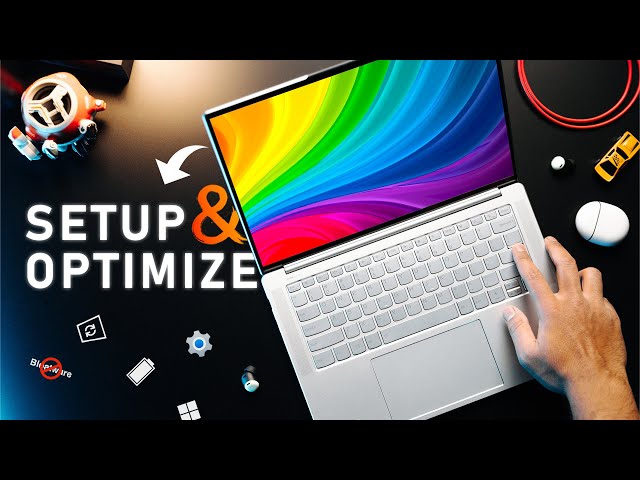
optimize laptop for gaming
How to optimize laptop for Gaming tips and tricks by Techworld0
Table of Contents
Laptop Gaming: How To Optimize Laptop For Gaming
Gaming is a constantly evolving field, so you need a powerful laptop for an immersive experience. Even the best gaming laptops need a few tweaks to get the most out of their gaming sessions, though. Here in this article, we are going to introduce you with the best tips and tricks to optimize your laptop for gaming to boost performance, graphics and great gameplay.
Know Your Laptop Specs
Understanding Laptop Specification Before Optimization Techniques Important parts that impact your gaming performance are:
Processor (CPU): Your laptop’s brain; a more robust CPU can run more tasks concurrently.
Graphics Card (GPU): Handles image and graphics rendering; you need a dedicated GPU for gaming.
RAM: More RAM will give better multitasking and smooth gaming performance.
Storage: Faster than traditional HDDs, so your boot times are faster.
Understanding your specifications allows you to find areas where optimization is necessary.
Maximize Your Laptop for Gaming: Tips and Tricks
Update Graphics Drivers
Update Graphics Drivers: One of the easiest yet most effective optimization of the laptop for gaming is to update the graphics drivers. We normally see new drivers from our manufacturers NVIDIA and AMD that offer performance and bug fixes for games.
To update your drivers:
- Go to the official website of the GPU manufacturer.
- Install the new drivers from the official site for your specific GPU model.
- Download the updates and restart your laptop.
- Enable Game Mode in Windows
The built-in Game Mode feature in Windows 10 and 11 is designed to improve gaming performance. Game Mode is an option in OX that, when turned on, allocates more resources to your games and minimizes background tasks.
To enable Game Mode:
- While in a game, press Windows + G.
- To do this, click the settings gear icon.
- Switch Game Mode to “On.”
- Optimize Power Settings
Tweaking your laptop’s power settings can make a world of difference to its gaming performance. Power Plan: Set to High Performance. A high-performance power plan will allow your CPU and GPU to run at full capacity.
To change power settings:
- No: Open Control Panel > Power Options.
- Choose High Performance or Ultimate Performance.
- Make advanced configuration tweaks as necessary (like turning off USB selective suspend and making sure that the hard disk never turns off, for example).
Manage Background Processes
While you’re gaming, background apps can suck up valuable resources. Closing unused programs will free up RAM and CPU power.
Managing Background Processes:
- Launch the Task Manager (Ctrl + Shift + Esc).
- Under the Processes tab, review running applications.
- Use Ctrl+Shift+Esc to bring up Task Manager.
And turn off startup programs you don’t want running when you boot up the computer:
- Open the startup tab from the Task Manager.
- Close unnecessary programs.
Optimize In-Game Settings
Tweaking in-game settings can greatly enhance performance with little visual compromise. Some common adjustments include:
- Lower resolution: One of the cleverest methods is lowering the resolution, this can have a significant boost on frame rates.
- Lower graphics settings: Scale down textures, shadows, effects, and so on according to the capacity of your hardware.
- Tear free experience — to turn on VSYNC, which eliminates screen tearing, but may bring frame rates down.
Upgrade Hardware Components
If you take gaming seriously, upgrade hardware components where you can:
- Increase RAM: Adding more (8GB or 16GB or more) will help in multitasking.
- Add an SSD: If your laptop has an HDD, consider upgrading to an SSD, which will dramatically reduce load times.
Explore cooling options: It’s paramount to facilitate adequate cooling, through the addition of a cooling pad or an upgrade of internal cooling systems for brisk gaming sessions.
Clean Your Laptop Regularly
Overheating Due to Dust Accumulation and Bad Performance Cleaning vents and fans regularly promotes proper airflow.
To clean your laptop:
BLOW OUT DUST FROM VENTS USING COMPRESSED AIR
- Use a microfiber cloth to wipe down surfaces.
- Turn Off Unneeded Visual Effects
There are a few visual effects in Windows that can take a toll on performance for gaming:
- Right-click on This PC, and then select Properties
- Click Advanced system settings.
- Now, from the Performance section, click on the Settings.
- Choose “Adjust for best performance” or turn off specific effects manually.
Optimize Storage Space
You should have enough storage for optimal performance:
- Delete games or apps you no longer play with.
- Clean temporary files from your system with a disk cleanup tool.
- If you are storing large files (such as videos), consider moving those files to an external disk drive or cloud storage.
Monitor System Temperatures
Monitoring system temperatures is important during heavy gaming session:
- To monitor CPU and GPU temperatures, go for monitoring software such as HWMonitor or MSI Afterburner.
- If overheating occurs (often if temps are high, say >85°C), be sure to improve cooling solutions or lower load through in-game settings.
FAQS
How to set up my laptop for gaming?
The best way is updating graphics drivers, turning on Game Mode in Windows, tweaking power settings, managing background processes, and optimising in-game settings for each piece of hardware.
So just how often should I be updating my graphics drivers?
Check for updates at least once a month, or whenever you experience issues with specific games.
How can I make my laptop better at gaming without spending money on hardware?
Yes! Playing around with a few optimizations, like how to manage background processes, set power modes, reduce the amount of storage space filled, and improve in-game settings can radically improve performance without having to spend a cent on a new hardware.
At what Temp should my laptop run at while gaming?
85°C is generally the max you want, so your laptop will ideally want to stay under that limit for the most part during an intense gaming session; above that may lead to thermal throttling, or could cause some damage over time.
Do I have to use a cooling pad?
We say ‘essential’ as a cooling pad is not required, but they do help keep lower overall temperatures during long gaming sessions, which increases performance and the life of the hardware.
Conclusion
If you have demanding titles to play, optimizing your laptop for gaming is a must to enjoy the best user experience. Your laptop can run smooth for the max FPS gaming sessions just by reading these tips and tricks on how to optimize your laptop for gaming.
Updating drivers, managing background processes, adjusting in-game settings, and hardware upgrades—are all steps that you can take to improve in-game performance! Irrespective of whether you play just to kill time or focus on climbing the leaderboard for maximum performance, following these tips for optimal gameplay will ensure you make the most of your gaming laptop.



